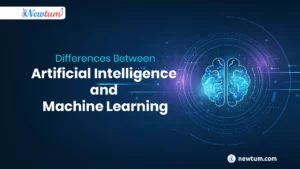AI interviews are vital as they assess a candidate’s grasp of complex algorithms, data analysis, and practical AI problem-solving skills. They help identify top AI talent in a competitive job market. In this blog, we’ll explore common interview questions to help both interviewees and interviewers better prepare for AI-related discussions.
Basic AI Interview Questions
1. What is Artificial Intelligence?
Answer: Artificial Intelligence is a way of making a computer, a computer-controlled robot, or software think intelligently, in a similar manner the intelligent humans think. AI is accomplished by studying how the human brain thinks, and how humans learn, decide, and work while trying to solve a problem, and then using the outcomes of this study as a basis of developing intelligent software and systems.
2. What are the objectives of Artificial Intelligence?
Answer: To Create Expert Systems: The systems that exhibit intelligent behavior, learn, demonstrate, explain, and advise its users. To Implement Human Intelligence in Machines: Creating systems that understand, think, learn, and behave like humans.
Learn about For loops in Python and level up your programming skills today!
3. What are the foundational fields contributing to the development of artificial intelligence (AI)?
Answer: Artificial intelligence is a science and technology based on disciplines such as Computer Science, Biology, Psychology, Linguistics, Mathematics, and Engineering. A major thrust of AI is in the development of computer functions associated with human intelligence, such as reasoning, learning, and problem-solving.
4. Which programming languages are commonly used in AI development?
Answer: In AI development, several programming languages are widely used. Python is the most popular due to its extensive libraries and community support. Other languages like R, Java, and Lisp are also employed in AI projects, depending on specific requirements.
5. How does programming with and without AI differ?
Answer: Programming without AI typically involves writing explicit instructions to solve a problem, while programming with AI leverages machine learning and data-driven algorithms to enable systems to learn and adapt to tasks, reducing the need for explicit programming. AI-driven programming is more dynamic, self-improving, and capable of handling complex, unstructured data.
Programming without AI often requires extensive manual coding to cover various scenarios, making it time-consuming and less adaptable to changing conditions. With AI, systems can generalize from data, allowing them to tackle a wider range of situations independently, albeit with data and training requirements.
6. Where has AI found dominance across various fields?
Answer: AI has achieved dominance in diverse fields, including healthcare (diagnosis and treatment recommendations), finance (algorithmic trading and fraud detection), autonomous vehicles (self-driving cars), natural language processing (virtual assistants), and manufacturing (robotics and automation). These applications demonstrate the versatility and transformative potential of artificial intelligence.
7. What are the types of AI?
Answer: There are primarily three types of AI: Narrow or Weak AI, which is designed for a specific task, General or Strong AI, which possesses human-like intelligence across various tasks, and Artificial Superintelligence, which surpasses human intelligence in all aspects. Each type serves different purposes and has varying levels of complexity and capabilities.
8. What is machine learning, and why is it significant in the field of artificial intelligence?
Answer: Machine learning is a subset of artificial intelligence that focuses on the development of algorithms capable of learning from data and making predictions or decisions based on it. It’s crucial in AI because it empowers systems to improve their performance on a specific task through continuous learning from experience, enabling them to handle complex and dynamic real-world scenarios effectively.
9. What are the three primary types of machine learning?
Answer: The three main types of machine learning are supervised learning, unsupervised learning, and reinforcement learning. Supervised learning involves training a model with labeled data to make predictions, unsupervised learning deals with unlabeled data and finding patterns within it, while reinforcement learning focuses on training models to make sequences of decisions to maximize rewards in specific environments.
10. Where do you see the future of AI heading, and what are the challenges it may face?
Answer: The future of AI holds tremendous potential, with AI becoming increasingly integrated into various aspects of our lives, from healthcare to transportation and beyond. However, it also faces significant challenges, such as ethical concerns, data privacy issues, and the need for comprehensive regulations to ensure responsible and safe AI deployment. Balancing innovation with ethical considerations will be a critical aspect of AI’s future.
11. How does reinforcement learning work, and what are some real-world applications?
Answer: Reinforcement learning is a type of machine learning where an agent learns to make a sequence of decisions to maximize a reward. Real-world applications include autonomous robotics, recommendation systems, and game playing, such as AlphaGo.
12. What is the significance of deep learning in real-world applications?
Answer: Deep learning plays a vital role in real-world applications by enabling tasks such as image and speech recognition, natural language processing, autonomous driving, and even healthcare diagnostics through its ability to analyze and learn from complex, unstructured data.
13. What is Natural Language Processing (NLP)?
Answer: Natural Language Processing (NLP) is a subfield of artificial intelligence that focuses on the interaction between computers and human languages. It involves developing algorithms and models to enable computers to understand, interpret, and generate human language text or speech.
14. Why are popular AI libraries or frameworks, important in AI development?
Answer: These libraries are essential because they offer pre-built tools for neural network training, natural language processing, and machine learning, significantly expediting the development process.
15. What is the concept of AI ethics, and why is responsible AI development important?
Answer: The concept of AI ethics involves establishing guidelines and principles for the ethical development and deployment of artificial intelligence. Responsible AI development is crucial to ensure AI systems are used in ways that respect human values, rights, and well-being, and to prevent potential harm or bias in AI applications.
Dive into our interview question bank and equip yourself with the knowledge needed to excel in Java interviews!
AI Interview Questions for Experienced
1. What are the key differences between supervised and unsupervised learning in machine learning?
Answer: Supervised learning involves training a model on labeled data, where the output is known. In unsupervised learning, the model identifies patterns and relationships in data without labeled output.
2. Can you explain the bias-variance trade-off in the context of machine learning models?
Answer: The bias-variance trade-off refers to the balance between underfitting (high bias) and overfitting (high variance). Models with high bias are too simple, while models with high variance fit the training data but generalize poorly to new data.
3. What is the concept of explainable AI (XAI), and why is it important in AI applications?
Answer: XAI focuses on making AI systems’ decision-making processes transparent and interpretable. It’s essential for building trust, regulatory compliance, and understanding AI-driven decisions.
4. Can you discuss the limitations and potential risks of deploying AI in autonomous vehicles?
Answer: Limitations and risks in deploying AI in autonomous vehicles include safety concerns, ethical considerations, and technical challenges related to real-time decision-making in dynamic environments.
5. Explain the concept of transfer learning and provide an example of its application.
Answer: Transfer learning involves using pre-trained models to boost performance on new, related tasks. For instance, using a pre-trained image classification model to improve a custom image recognition model.
6. How does a convolutional neural network (CNN) differ from a recurrent neural network (RNN)?
Answer: CNNs are suitable for image-related tasks and spatial data due to their convolutional layers, while RNNs are designed for sequence data like time series and text, utilizing recurrent connections.
7. What are the common activation functions used in neural networks, and when should you use each one?
Answer: Common activation functions include ReLU, Sigmoid, and Tanh. ReLU is preferred for hidden layers due to its efficiency, while Sigmoid and Tanh are used in output layers for binary and multi-class classification, respectively.
9. Describe the working principle of reinforcement learning and its real-world applications.
Answer: Reinforcement learning uses trial and error to make decisions, best suited for tasks with sequential actions, such as game playing, robotics, and autonomous driving.
10. Can you compare and contrast unsupervised clustering algorithms such as K-Means and hierarchical clustering?
Answer: K-Means is a partitioning algorithm that divides data into clusters. Hierarchical clustering creates a tree-like structure, allowing for nested clusters. K-Means is more efficient but requires specifying the number of clusters.
11. Describe the steps involved in training a deep learning model using TensorFlow or PyTorch.
Answer: Training a deep learning model involves data preprocessing, model architecture design, selecting loss functions and optimizers, and fine-tuning hyperparameters using training and validation data.
12. Discuss the ethical considerations in AI, including bias, fairness, and transparency.
Answer: Ethical considerations in AI involve addressing bias in data and algorithms, ensuring fairness, and maintaining transparency in AI systems to avoid unintended consequences.
13. How do you handle missing data in machine learning datasets, and what imputation techniques are available?
Answer: Missing data can be handled by removing rows, using imputation techniques like mean, median, and mode imputation, or employing advanced techniques like regression imputation.
14. Describe the role of convolutional neural networks (CNNs) in computer vision tasks and object detection.
Answer: CNNs are designed for feature extraction in image data, making them ideal for computer vision tasks. Object detection combines CNNs with techniques like YOLO (You Only Look Once) to locate and classify objects within images.
15. What are the challenges of scaling machine learning models to big data, and how can you address them?
Answer: Scaling machine learning models to big data requires handling data storage, efficient processing, and parallelization. Techniques like distributed computing and data sharding help address these challenges.
These concise answers provide insights into various aspects of artificial intelligence and machine learning, suitable for experienced candidates preparing for AI interviews.
Sample Interview Scenarios
1. Imagine you’re working on a natural language processing project, and the model starts generating biased outputs. How would you identify and mitigate this bias in the NLP model?
Answer: To address bias in the NLP model, I would start by analyzing the training data to identify biased language patterns. Then, I would use techniques like data augmentation, re-sampling, or adding fairness constraints during training to reduce bias. It’s also essential to continually monitor model outputs and retrain it as necessary to ensure fairness.
2. You’re tasked with building a recommendation system for an e-commerce platform. What machine learning algorithms and data sources would you consider for this project, and how would you evaluate its performance?
Answer: For a recommendation system, I would consider collaborative filtering, content-based filtering, and hybrid models. Data sources would include user behavior, item features, and user-item interactions. To evaluate performance, I would use metrics like precision, recall, and mean average precision, and I would implement A/B testing to assess real-world impact.
3. You’re working on a computer vision project for object detection, and the model is failing to recognize certain objects in low-light conditions. How would you improve the model’s performance in such scenarios?
Answer: To enhance object detection in low-light conditions, I would consider using data augmentation techniques to simulate low-light scenarios during training. I might also explore using pre-processing methods to adjust image brightness and contrast. Additionally, leveraging transfer learning from models trained on low-light images could improve performance.
4. Your team is developing a chatbot for customer support. How would you design the chatbot’s natural language understanding (NLU) component, and what tools or frameworks would you use?
Answer: I would design the NLU component using a combination of rule-based and machine learning-based approaches. I’d employ tools like spaCy or NLTK for text processing and entity recognition. Machine learning frameworks like TensorFlow or PyTorch would be valuable for training models to understand user intents.
5. You’re tasked with building a sentiment analysis model for social media data. How would you handle noisy and unstructured text data, and what algorithms would you consider for sentiment analysis?
Answer: To handle noisy text data, I’d employ techniques like text cleaning, tokenization, and stop-word removal. For sentiment analysis, I’d consider using machine learning models like Naive Bayes, and SVM, or deep learning models like LSTM or BERT. It’s crucial to fine-tune these models on labeled sentiment data for accuracy.
6. You’re working on a computer vision project involving facial recognition, and you need to address privacy concerns. How would you implement privacy-preserving techniques in your facial recognition system?
Answer: I would incorporate privacy-preserving techniques such as differential privacy, federated learning, or homomorphic encryption to protect sensitive facial data. Additionally, I’d consider anonymizing the data by removing personally identifiable information and ensuring strict access controls to the facial recognition system.
7. Your team is developing an autonomous vehicle navigation system using reinforcement learning. What challenges might you encounter in this project, and how would you mitigate them?
Answer: Challenges in autonomous vehicle navigation include safety, real-time decision-making, and handling unpredictable environments. I’d mitigate these challenges through rigorous testing in simulated environments, continuous monitoring, and the development of fallback mechanisms to ensure safe operation in unexpected situations.
8. You’re working on a project involving anomaly detection in network traffic data. How would you select appropriate features and algorithms to detect anomalies effectively?
Answer: I would choose features relevant to network traffic behavior, such as packet size, source-destination relationships, and traffic patterns. For anomaly detection, algorithms like Isolation Forest, One-Class SVM, or autoencoders are suitable. Feature scaling and preprocessing are also essential for accurate anomaly detection.
9. Your team is developing a recommendation system for a streaming platform. How would you handle the “cold start” problem, where new users or items lack sufficient historical data for recommendations?
Answer: To address the cold start problem, I would employ content-based recommendations for new items, considering their characteristics. For new users, I might initially recommend popular or trending items. As users provide more feedback, I’d gradually transition to collaborative filtering and personalized recommendations.
10. You’re responsible for implementing continuous learning and model monitoring for an AI system. How would you set up a system to ensure that models remain effective and compliant over time?
Answer: To enable continuous learning and model monitoring, I would establish a feedback loop that collects user feedback and performance metrics. This data would be used to retrain models and assess their performance regularly. Compliance checks, version control, and automated alerts for anomalies would be crucial components of the system.
Check out Python Interview Questions and Answers, Now!
Preparation Tips for Interview on AI
Preparing for AI interviews is crucial for success. Here are some key tips:
1. Understand the Basics: Review fundamental AI concepts like machine learning, deep learning, natural language processing, and computer vision. Ensure you have a strong grasp of algorithms and techniques commonly used in AI.
2. Coding Practice: Practice coding AI algorithms. Implement models from scratch, work on AI-related coding challenges, and understand the mathematics behind these algorithms.
3. Stay Informed: Keep up with recent AI developments by reading research papers, blogs, and news articles. Familiarize yourself with the latest trends and breakthroughs in the field.
4. Hands-On Experience: Prepare real-world examples of AI projects you’ve worked on. Be ready to discuss the challenges you faced, the methodologies you employed, and the results you achieved.
5. Problem-Solving: AI interviews often involve problem-solving scenarios. Practice analyzing AI problems, proposing solutions, and discussing the pros and cons of different approaches.
6. Communication Skills: Develop strong communication skills. You should be able to explain complex AI concepts clearly and concisely. Practice discussing your AI work and findings with others.
7. Mock Interviews: Consider participating in mock interviews. These can help you get a sense of the interview process and receive feedback on your performance.
8. Behavioral Questions: Prepare for behavioral questions that assess your soft skills, teamwork, and adaptability. Provide examples of how you’ve demonstrated these skills in your AI projects.
9. Ask Questions: Don’t hesitate to ask questions during the interview. Clarify doubts about the company, team, or the AI projects you’ll be working on.
10. Portfolio: If applicable, create a portfolio showcasing your AI projects, research, and publications. This can serve as a valuable reference during the interview.
Remember that AI interviews assess not only your technical knowledge but also your problem-solving abilities and your capacity to apply AI concepts to real-world situations.
AI interviews gauge a candidate’s ability to work with complex algorithms, data, and emerging technologies. By mastering AI concepts, staying ethical, and continually learning, both interviewees and interviewers can contribute to the ever-evolving field of Artificial Intelligence. Good luck with your AI interviews!
We hope that you found this blog “ Interview Questions on AI” was informative and useful. Explore the Newtum official website for more about our programs, including PHP, C Programming for kids, and Happy Coding!



